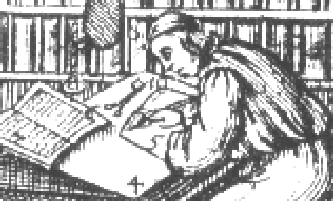 |
Text Encoding Initiative |
The XML Version of the TEI Guidelines<direction> |
| <direction> | specifies one or more conventional directions in which a language is written using a given script. | |
| Attributes | (In addition to global attributes) | |
| Example |
<writingSystemDeclaration lang="eng" id="DEU"
name="-//TEI P2: 1993//WSD Modern German//en" date="1993-06-01">
<language iso639="deu">New High German</language>
<script>Latin script with diacritics.</script>
<direction chars="LR" lines="TB"/>
<!-- ... -->
</writingSystemDeclaration>
|
|
| Example |
If more than one direction is specified, it means that the script in question may be written in any of the directions named. In some cases, the directions may be mixed within a single document, in others not; no information is given on this point by the writing system declaration, as it is not usefully formalizable. Experts on the script must be consulted for details. The following example shows one way to declare that a script may be written in any horizontal or vertical direction: <writingSystemDeclaration lang="eng" id="JPN"
name="-//TEI P2: 1993//WSD JIS 0208//en" date="1993-06-01">
<language iso639="jpn">Modern Japanese</language>
<script>normal Japanese writing, with mixture of hiragana,
katakana, and kanji.</script>
<direction chars="LR" lines="TB"/>
<direction chars="RL" lines="TB"/>
<direction chars="LR" lines="BT"/>
<direction chars="RL" lines="BT"/>
<direction chars="TB" lines="LR"/>
<direction chars="BT" lines="LR"/>
<direction chars="TB" lines="RL"/>
<direction chars="BT" lines="RL"/>
</writingSystemDeclaration>
The following example shows another way to specify that a script may
be written in any horizontal or vertical direction:
<writingSystemDeclaration lang="eng" id="JPN"
name="//TEI P2: 1993//WSD JIS 0208//en" date="1993-06-01">
<language iso639="jpn">Modern Japanese</language>
<script>normal Japanese, with mixture of hiragana, katakana,
and kanji.</script>
<direction chars="LR RL" lines="TB BT"/>
<direction chars="TB BT" lines="LR RL"/>
</writingSystemDeclaration>
In some cases, the lines and chars attributes
may need to take special values. Some scripts are written in
`boustrophedon' (turning back and forth): i.e. one
line is written left to right, the next right to left, and so on. Such
a writing system might have its direction declared as shown:
<direction chars="boustrophedon: LR, then RL, then LR, etc."
lines="TB"/>
|
|
| Note |
This element describes conventional presentation; all scripts are subject to unusual treatment in special circumstances, and such unusual directions need not be described here. The treatment of numerals in Latin, Hebrew, and Arabic script, being well understood, need not be documented separately here.188 The <direction> element is informational only, not normative. It is intended to alert those responsible for implementing support for a given writing system to an essential fact of how it is written. If only a single direction is specified, it is safe to infer that the script may legitimately be presented in that direction. If multiple directions are specified, it may be legitimate to present text in any one of them, or it may be necessary to support multiple directions in display of a single document. If the latter, then changes of direction should be given using the global rend attribute. If no direction element is given, the only safe assumption is that any direction is possible and experts must be consulted before attempting to implement support for the writing system. |
|
| Module | Declared in file teiwsd2; Auxiliary tag set for Writing System Declarations | |
| Data Description | Empty. | |
| May occur within | ||
| Declaration |
<!ELEMENT direction %om.RO; EMPTY>
<!ATTLIST direction
%a.global;
chars CDATA #REQUIRED
lines CDATA #REQUIRED>
|
|
| See further | 25.3 Describing the Writing System; 25.1 Overall Structure of Writing System Declaration | |
Up: 35 Elements